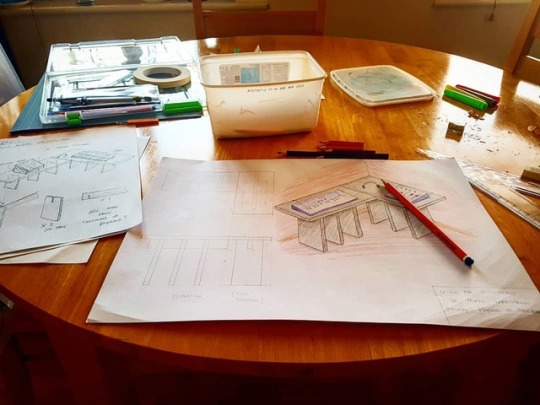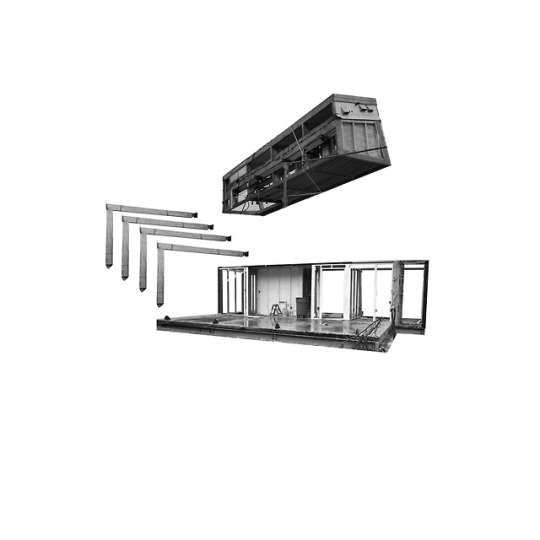#designfordisassembly
Photo

Design for disassembly provides great possibilities for reuse and beautiful projects. Café Kureon, Toyama City, Japan. By @kkaa_official . . . #circulareconomy #design #designfordisassembly #wood #woodarchitecture #nature #architecturephotography #japan #travel #art #cafe (her: Toyama, Toyama) https://www.instagram.com/p/CERv1sPH-u2/?igshid=7c8n467p3hsi
#circulareconomy#design#designfordisassembly#wood#woodarchitecture#nature#architecturephotography#japan#travel#art#cafe
0 notes
Video
vimeo
Dealing with SIPs
Following up on Lana’s post, this slow-motion clip shows how the Structural Insulated Panels (SIPs) were processed after being dismantled and placed on the ground. The chunks were too bulky to be transported and thus had to be cut up into smaller pieces for easier handling and sale-ability, as Lana mentioned. The clip shows Brian from Construction Junction at work with a chainsaw. Once he finished, we helped load the pieces into the truck for them to be taken to Construction Junction.
#UDBS#UrbanDesignBuildStudio#weareUDBS#PROJECTRE_#projectrepgh#wearePROJECTRE#CarnegieMellonUniversitySchoolofArchitecture#CarnegieMellonUniversity#CMU#CMUUDBS#CMUSoA#SoA#SoAUDBS#SolarDecathlonHouse#DE_CON01#materialharvest#materiality#designfordisassembly#deconstruction#precedent#residential#design#HOME#RE_CON01#SIP#ConstructionJunction#DECONSTRUCTING BLIGHT#ScalingChange#submission
0 notes
Photo

#Design mess. #DesignForDisassembly #VictorPapanek #JamesHennessey #NomadicFurniture #CollegeProject
0 notes
Photo

DE_CON 01 Structures
Zooming back out, I wanted to present some of the things I learned in observing the deconstruction of the structural members of the CMU Solar Decathlon building during DE_CON 01. After removing of the finishing, solar panels and mechanical equipment deconstruction of the structure occurred. The unveiled structure is elegant itself: PSL members in the main room and composite lumber beams and columns on the other side of the building. The beams and columns are joined together by means of 5/16” thick metal plates and hex drive, partially threaded bolts.
Under the loft lumber, primary members were joined via a bridle connection and fixed with a 5/16” thick metal plate on the other whereas secondary members, standing on the edge, were joined by Simpson hangers. Flat-lying beams were end-nailed.
After dismantling the SIP panels from the walls, the roof SIPs were taken down by a crane. Then PSL structure was loosened with sockets and ratchets and placed on the ground for further manual disassembly. Finally, the rest of the structure, the ground floor and the loft beams and columns were disassembled in a few hours.
#UDBS#UrbanDesignBuildStudio#ProjectREPgh#CMUSoA#CarnegieMellonUniversity#CMU#RE_CON01#DE_CON01#structure#beams#joinery#PSL#DesignForDisassembly#deconstruction#fasteners#learning#details#architectureschool#reuse#material#submission
0 notes
Photo

The Reciprocating Saw a.k.a. Sawzall a.k.a Tool of Mass Deconstruction
The reciprocating saw (also known as an oscillating saw or referred to by the Milwaukee Tool Company brand name Sawzall) was a crucial member of the deconstruction toolkit. Able to make quick and dirty cuts, it proved very useful for a number of applications where more delicate procedures were not an option. The ability to change the blade to suit different applications provided a versatility that allowed the deconstruction/processing of materials and assemblies, including windows, the polycarbonate panels, the plumbing system, and the structurally insulated panels (SIPs). It was used not only to cut material into smaller, more manageable pieces, but also to free materials from the assembly by cutting through screws and nails. The reciprocating saws used during the deconstruction process varied from cordless to corded to allow for more ease in use where convenient and were spread among different stations based on proximity to power and ease of use. And although too rough for more intricate details (ex. Southern Exposure previously mentioned in Yash and Gargi’s posts), the reciprocating saw was efficient where there was a significant margin of error and space around the cut to enable a safe cut that would not damage the surrounding material.
As we develop the design of RE_CON 01, my experiences using the reciprocating saw on DE_CON 01 are making me think more about the benefits of Design for Deconstruction (DfD). In proper DfD, assemblies should be easily disassemblable so that the components can be reused or recycled without much damage to the material; ideally, you should not need a reciprocating saw to deconstruct components of the building. Bolted or screwed connections that can be accessed with the proper tools are preferred over nailed, inaccessible connections. Reflecting on these experiences from DE_CON 01 will help the studio make intelligent decisions regarding details and assemblies as we get into the weeds with the RE_CON 01 Construction Documents set.
#UDBS #UrbanDesignBuildStudio #weareUDBS #wearePROJECTRE_ #PROJECT RE_ #projectrepgh #CarnegieMellonUniversity #CarnegieMellonUniversitySchoolofArchitecture #CMUSoA #CMU #CMUUDBS #SoA #SoAUDBS #CMUFMCS #DE_CON01 #RE_CON01 #RYCONConstruction #RYCON #BMRA #BuildingMaterialReuseAssociation #ConstructionJunction #Deconstruction #NotDemolition #MaterialReuse #MaterialRepurposing #MaterialHarvesting #ZeroWaste #Extraction #Tools #ReciprocatingSaw #Sawzall #learning #DesignForDisassembly #DFD
0 notes